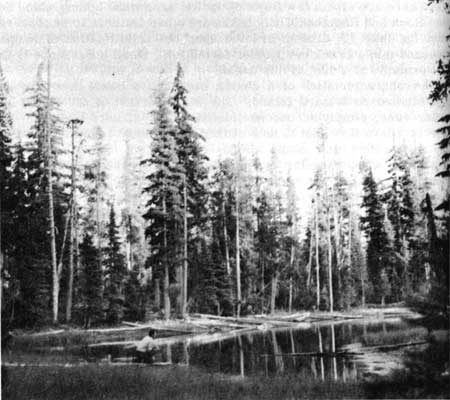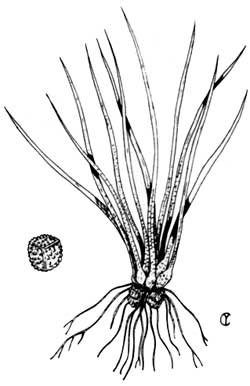The “Lost” Pond (Crater Lake National Park)
One of the few permanent ponds in Crater Lake National Park is located along the south entrance road a short distance north of the Cold Spring Campground. To reach this interesting body of water, it is necessary to drive into an old stone quarry on the west side of the south entrance road about one-half mile north of Cold Spring. The pond can then be found by climbing around the south end of the quarry and walking about 200 yards to the west. It is located at 6250 feet altitude, is about 300 feet long and 100 feet wide and has a maximum depth of approximately four feet.
Curiously, this pond has in the past periodically become “lost.” It is not shown on the topographic map, consequently, when those who know its location leave the service of the park, there is no way for newcomers to find it. During the early part of the 1951 season, Dr. Donald S. Farner told us that he had seen this little body of water during his first season in the park but had not found it since that time. He suggested that we locate it because, being permanent, it had the possibility of containing animals and plants that would not be found in the temporary ponds which exist in other parts of the park.
Our inquiries among the members of the park personnel revealed that the pond was not quite as lost as we had originally thought. Ranger Paul Turner had seen it in 1938, electrician James Kilburn had visited it as recently as 1950 and Charles True, for many years a worker at Crater Lake, had climbed around the quarry to this body of water about 18 years ago. However, the fact remained that it had been seen only infrequently and, as far as we could learn, had never been explored for plants and animals.
On the evening of September 5,1951, we made the climb around the quarry and found this elusive pond. The accompanying photograph shows how it appeared to us at that time. We were delighted to discover that the bottom of the pond was covered with a plant that had not previously been recorded from the park. This curious species is a quillwort, Isoetes braunii Durieu, a non-flowering vascular plant in which the spores are borne in sporangia that are imbedded in the basal portions of the quill-like leaves. Dr. Charles F. Yocom has prepared a drawing of this quillwort which shows clearly both its general structures and the detailed appearance of its megaspore as seen under magnification. The quillworts were growing so abundantly over the bottom of the pond that, as one waded through the water, he left a trail of uprooted quillwort behind him.
We have recorded the position of this pond on the large map that is kept in the Ranger’s office. Perhaps that record and this Nature Notes article will enable future park workers and visitors to find and enjoy this beautiful and interesting aspect of Crater Lake National Park.
Quillwort Pond
As might be expected from his articles in this issue, salamanders are the chief interest in the life of Ranger- Naturalist James Kezer. A good observer clad in hip-boots, he spent his free time last summer in the wet, boggy spaces of the park and Oregon Caves National Monument. The result was the addition of several aquatics to the flora of the regions. His first find was a quillwort, Isoetes sp., in Lower Biglow Lake above Oregon Caves. Later he found his “lost” pond near Arant Point floored with it.
Tho it is not indicated upon park maps, this small pond was not unnoticed in the past. There is a current story that it was planted with fingerlings in the early thirties. Their introduction was the signal for numbers of pelicans to visit the shallow waters until the last fish was consumed. Former park ranger Jack Frost said that he had heard this story in 1936. He made two trips to the pond in 1937, never to see waterfowl of any kind on or near the water.
Permanent ponds inside the park boundaries are rare. Because of its history, the park concluded that this pond should bear an official name. For the purpose, I weighed the possibilities of Isoetes, what with its Greek origin, euphony, and dieresis, but settled instead on simple “Quillwort Pond” to propose through channels to the Board on Geographic Names.
The plant is of interest. Its nearest relatives are the club mosses and scouring rushes (equisetums or horsetails). They are aquatic or marshloving, and have been traced back in geological time to the Miocene. They are characterized by an extremely short, corm-like stem from which grow 10 to 100 quill-shaped leaves. The bases of the leaves are spoon-shaped, in which grow the fruiting bodies or sporangia that are of two sizes and kinds. Larger spherical macrospores occur in the outer leaves while numerous, triangular microspores grow in the inner leaves. Size and sculpturing of the spores form the important differences between species.
The park specimens were examined by Dr. L. R. Detling of the University of Oregon who identified them as I. braunii Durieu. He bases his conclusion on the presence of very long papillae, almost spines, on the megaspore coat. Dr. LeRoy Abrams of Stanford gives the range of this species as far northern, coming southward only into Washington and Idaho. Further investigation will be reported in a future issue.
***previous*** — ***next***



